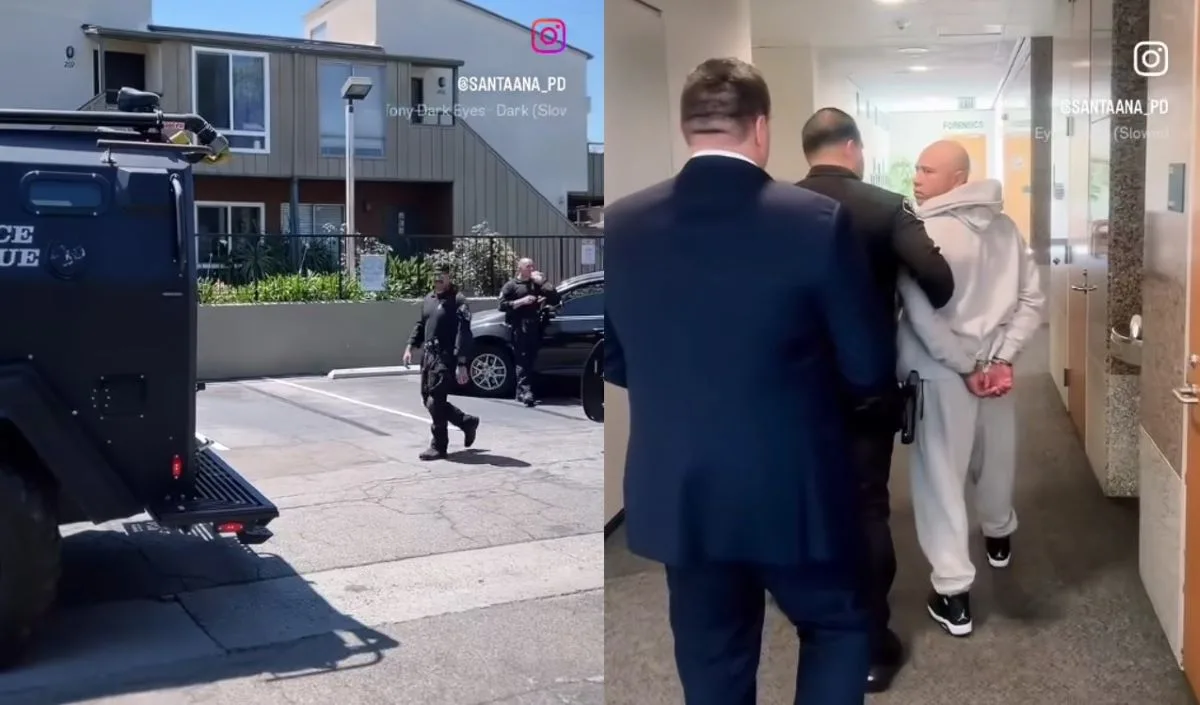Yesterday afternoon, SAPD SWAT operators served a warrant at an apartment complex for a suspect wanted in an assault with a deadly weapon investigation.
Earlier this month, the suspect pointed a handgun at his neighbor and discharged the weapon once, narrowly missing the victim’s feet.
The police officers attempted to contact the suspect at his residence, but he had fled prior to their arrival.
During a safety sweep, over 1,000 rounds of ammunition were recovered from the suspect’s bedroom.
Thanks to the collaborative efforts by our officers, detectives, and SWAT personnel, the suspect was taken into custody without incident.
He was subsequently booked into the Santa Ana Jail for assault with a deadly weapon and possession of a firearm and ammunition.
The arrested suspect is facing significant penalties under California law due to the combination of charges: assault with a deadly weapon (a firearm), and possession of a firearm and ammunition. The fact that he shot at a neighbor, even if he missed, and possessed over 1,000 rounds of ammo will likely lead to severe prosecution.
Here’s a breakdown of the potential penalties based on California Penal Code:
1. Assault with a Deadly Weapon (Firearm) – California Penal Code 245(a)(2) PC:
- This is a “wobbler” offense, meaning it can be charged as either a misdemeanor or a felony. However, given the use of a firearm and the intent to shoot, it will most likely be prosecuted as a felony.
- Felony Penalties:
- Imprisonment in state prison for two, three, or four years.
- A fine of up to $10,000.
- Can fall under California’s “Three Strikes Law,” which can significantly increase sentences for future convictions.
- If the firearm was a semi-automatic, the state prison sentence could increase to three, six, or nine years.
- If the firearm was a machine gun, assault weapon, or .50 BMG rifle, the state prison sentence could be four, eight, or twelve years.
2. Possession of a Firearm by a Prohibited Person – California Penal Code 29800 PC:
- This charge applies if the man is prohibited from owning a firearm, which is highly probable given the assault charge and the fact that he was arrested. Common reasons for prohibition include:
- Prior felony conviction.
- Addiction to narcotics.
- Two or more convictions for specific misdemeanors (e.g., brandishing a weapon).
- This is a felony offense.
- Felony Penalties:
- Imprisonment in county jail (often served in state prison for felonies) for 16 months, two years, or three years.
- A fine of up to $10,000.
- Loss of gun rights for life.
3. Possession of Ammunition by a Prohibited Person – California Penal Code 30305(a)(1) PC:
- Similar to firearm possession, if he is prohibited from owning a firearm, he is also prohibited from possessing ammunition. The seizure of over 1,000 rounds will be a significant factor.
- This is also a “wobbler” offense, but given the circumstances, it will likely be charged as a felony.
- Felony Penalties:
- Imprisonment in state prison for 16 months, two years, or three years.
- A fine of up to $10,000.
Aggravating Factors and Enhancements:
The fact that the man shot at a neighbor, even if he missed, is a very serious aggravating factor. While the information doesn’t state if the neighbor was injured, the attempt itself is severe. This could lead to:
- Sentencing Enhancements: California has sentencing enhancements for the use of firearms in the commission of certain felonies. Penal Code Section 12022.5, for example, can add additional, consecutive years to a sentence for using a firearm in the commission of a felony.
- Attempted Murder: Although the information states he “missed,” if there was clear intent to kill the neighbor, he could potentially face charges of attempted murder, which carries much more severe penalties.
- Probation Unlikely: Given the nature of the crimes, especially the use of a firearm in an assault, it is highly unlikely he would be granted probation as an alternative to jail or prison time.
In summary, the man is facing multiple felony charges, each carrying potential prison sentences and substantial fines. The specific sentence will depend on various factors, including his criminal history, the exact details of the incident, and the discretion of the prosecutor and judge. He is likely looking at a significant period of incarceration.

This guy is a dumb ace, if he didn’t like his neighbor staring at him for whatever reason he could of just sprayed water on the neighbor with a garden hose.
Thank you for listing all the felonies, and penalties. I hope gun owners read this and feel less emboldened in future confrontations.